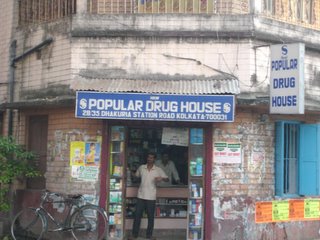I finally have a concrete action plan for my work here. Below is what in theory I am working on in the coming year. I know that a lot of individual steps are missing (and that they are not true goals and I don’t really have concrete objectives), but I would greatly appreciate if y'all have any feedback on my work plan. I'm probably over reaching here, but it's better to have too much to do that not enough. :-) Let me know what you think.
GoalTo strengthen the effectiveness of ARC’s programs by developing comprehensive interventions for youth sexual and reproductive health in collaboration with government and other key partners in West Bengal and Jharkand.
ActivityIntegrate HIV prevention interventions to ARC’s existing sexual and reproductive health programs in West Bengal and Jharkand.
Action StepsSocial DiagnosisAssess and inventory current HIV activities in WB and Jharkand, research effective HIV/RH programs.
- Literature Reviews
- Interviews with HIV/AIDS and youth serving organizations
- Mapping exercises of current interventions in WB and Jharkand
Epidemiological Diagnosis
Examples of Epidemiological data to be collected:
- Vital statistics
- Prevalence
- Morbidity
- Incidence
- Mortality
Behavioural & Environmental Diagnosis
Assess and analyze behavioural links to HIV risk taking among youth in ARC project areas along with factors in the social and physical environment that could be linked to behaviours.
Systematic identification of health practices and other factors that seem to be linked to HIV risk taking.
Include non-behavioural causes (personal and environmental factors) that can contribute to health problems, but are not controlled by behaviour. Determine the importance and relative changeability of each behavioural cause.
Education & Organizational Diagnosis
Analyze the causes of health behaviours Determine predisposing factors - any characteristics that motivates HIV risk taking prior to the occurrence of that behaviour
- Knowledge
- Attitudes
- Beliefs
- Behaviour
Determine enablers - characteristic of the environment that facilitates HIV risk taking and any skill or resource required to attain specific behaviour.
- Accessibility
- Availability
- Skills
- Laws (local, state, federal)
Determine reinforces - rewards or punishments following or anticipated as a consequence of behaviour.
Administrative & Policy Diagnosis
Determine administrative and organizational concerns which must be addressed prior to program implementation; collaborate with WB and Jharkand SACS and Youth Affairs Coordinator in this analysis.
Administrative Diagnosis:
Analysis of policies, resources and circumstances prevailing. Analysis of organizational situations that could hinder or facilitate the development of the HIV prevention programs.
Policy Diagnosis:
Assess the compatibility of the program goals and objectives with those of CINI and NACO and its administration.
Design and Implementation
Convene a workgroup for each state consisting of ARC staff, government representatives, peer leaders, and youth service recipient to develop and/or adapt HIV prevention interventions to be integrated into the existing sexual and reproductive health programs using the data gathered in the previous stages.
Facilitate a process for integrating and implementing the HIV interventions in the currently running projects in each state.
Outcome Evaluation
Measure the program effectiveness in terms of intermediate objectives and changes in predisposing, enabling, and reinforcing factors
Goal
To strengthen youth participation in SRH/HIV issues by developing leadership skills among youth
Activity
Develop a methodology for imparting advocacy skills for SRH/ HIV among youth leaders
Action Steps
Social Diagnosis
Assess and inventory current youth leadership activities in WB and Jharkand:
- research effective youth leadership programs
- inquire about perspectives of youth leadership among target population
- Literature Reviews
- Interviews with youth serving organizations
- Mapping exercises of current interventions in WB and Jharkand
- Focus groups with target populations
Administrative & Policy Diagnosis
Determine administrative and organizational concerns that must be addressed prior to program implementation collaborate with WB and Jharkand SACS/Regional and District Youth Coordinators in this analysis.
Administrative Diagnosis:
Analysis of policies, resources and circumstances prevailing
Analysis of organizational situations that could hinder or facilitate the development of the HIV prevention programs.
Policy Diagnosis:
Assess the compatibility of the program goals and objectives with those of CINI and NACO and its administration.
Internal (ARC) Capacity Building
Facilitate a process for developing a Youth Advisory Board (YAB) for ARC.
The YAB will serve to voice the needs and opinions of the target population, as well as, to foment leadership skills among the board members.
Development and Implementation
In collaboration with the YAB develop a methodology using the data gathered previously for instilling advocacy skills among youth leaders.
Facilitate a process for conducting youth leadership/advocacy building activities.
Outcome Evaluation
Measure the program effectiveness in terms of intermediate objectives and changes in predisposing, enabling, and reinforcing factors
Goal
To strengthen CINI’s ability to address SRH issues by increasing staff’s awareness and knowledge of overarching sex and sexuality issues and defining the concepts for use in programs.
Activity
Facilitate a process for expanding CINI’s concept of sex and sexuality and develop definitions to be used agency wide.
Action Steps
Situational analysis
Within ARC: Learn about staff’s understanding of sex and sexuality through:
- Guided discussions
- Informal focus groups with field workers
- Interviews with key individuals
Within CINI as a whole: Learn about senior management and other divisions’ staff understanding of sex and sexuality issues through:
- Guided discussions
- Views with key individuals
- Participation in CINI’s “Journal Club”
- Research sex and sexuality related topics and acquire tools and resources
Intervention Development
Develop training/in-service modules on Sex and Sexuality based on research findings and tailored to specific groups (e.g., upper management, program staff, and field worker).
The purpose of the training/in-service is to:
Foster an understating of sex and sexuality issues
Set the foundation for developing uniform definitions to be used across programs
Implement Activities
Conduct internal capacity building workshops/in-services
Follow-up trainings with guided discussions for forming uniform definitions.
Outcome Evaluation
Measure the program effectiveness in terms of intermediate objectives and changes in predisposing, enabling, and reinforcing factors
Evaluation Process
Process evaluation will be conducted throughout the project period to ensure progress. Process measurements include, but not limited to reports from each objective that will be used in designing the interventions.
 My vegetable lady. I make a conscious effort to support women run enterprises. In a country that there is still gender-based employment bias there is a reason for a women to be working. (aside from the upper-classes of course)
My vegetable lady. I make a conscious effort to support women run enterprises. In a country that there is still gender-based employment bias there is a reason for a women to be working. (aside from the upper-classes of course) Slums are a reality in many countries, however the mortality rates for people living along railroad tracks are higher than any other area.
Slums are a reality in many countries, however the mortality rates for people living along railroad tracks are higher than any other area. Golpark at night (the neighborhood where my office is) - It gets dark by 5:00 pm!
Golpark at night (the neighborhood where my office is) - It gets dark by 5:00 pm!
 Random factoid - Armenian immigrants came to India as traders, and established settlements in most major cities in India. Job Charnock allegedly invited the Armenians to Calcutta at the time of is founding in 1689 and created one of the largest Armenian communities in the country. This is one of the few buildings that still belong to their community.
Random factoid - Armenian immigrants came to India as traders, and established settlements in most major cities in India. Job Charnock allegedly invited the Armenians to Calcutta at the time of is founding in 1689 and created one of the largest Armenian communities in the country. This is one of the few buildings that still belong to their community.















































